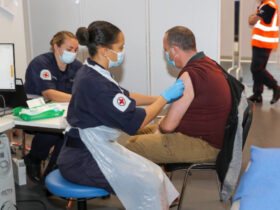In order to bring Marxian theory up-to-date with post-war capitalism, scholars have theorized the existence of a “professional-managerial class” or “PMC.” This class not only replaces the petit bourgeoisie, which is deemed disappeared by many modern-day Marxists and heterodox thinkers, but also serves to explain away the more well-remunerated members of what would have previously been understood as the proletariat, as “white-collar workers.”
But Marxism is not merely theoretical. While the PMC concept has some descriptive value, one need only apply the theory to the actual terrain of politics to see the way it blurs political allies with enemies (“We are the 99 percent!”), and muddies the differing role of various professionals within production, which is the key battleground for the proletariat. Updates to and elaborations on Marxism should serve to both understand the world and to change it. The PMC explanation fails on both counts.
The Origins of the PMC
John and Barbara Ehrenreich, the originators of the professional-managerial class concept, criticized “orthodox Marxism” for being unable to describe the managerial layer that grew within advanced capitalist nations during the 20th and 21st centuries. This group is described as being made up of “salaried mental workers who do not own the means of production and whose major function in the social division of labor may be described broadly as the reproduction of capitalist culture and capitalist class relations.” This class is, according to the Ehrenreichs, a “new class, not found in earlier stages of capitalist development.”
The PMC is a class totally distinct from the petit bourgeoisie (the “old middle class” of artisans, shopkeepers, self-employed professionals and independent farmers). The classical petit bourgeoisie lies outside the polarity of labor and capital. It is made up of people who are neither employed by capital nor themselves employers of labor to any significant extent. The PMC, by contrast, is employed by capital and it manages, controls, has authority over labor (though it does not directly employ it). The classical petit bourgeoisie is irrelevant to the process of capital accumulation and to the process of reproducing capitalist social relations. The PMC, by contrast, is essential to both.
But the petite bourgeoisie, as originally described by Marx, did indeed refer to the layer of small capitalists that precariously sat between labor and capital, and which acted as an intermediary between the numerically small capitalist class and the numerically large proletariat.
Marx forecasted that this “intermediate class” would be destroyed over the course of the normal development of capitalism (and indeed it periodically is when the system lurches into crises). However, the need for such an intermediary class between the numerically small bourgeoisie and the numerically large proletariat has not disappeared. Since the petite bourgeoisie has always fulfilled this intermediary role, it would be ludicrous to conclude that it would not evolve in the same way that the structure of capitalism evolves. This is the opposite of what one would expect from a class that lies “outside the polarity of labor and capital.”
In Imperialism Vladimir Lenin analysed the way in which the modern capitalist state expanded its economic role after the emergence of monopoly capitalism in the late 19th and early 20th centuries. Monopoly capitalism created the need for finance capital, which became (and remains) an inseparable part of modern-day capitalist states. In Lenin’s view this capitalism is qualitatively different from the industrial-style capitalism that came before it, requiring instead the expansion of the state to guarantee stability (as capitalists’ financial business investments had become fractured amongst hundreds of stakeholders, ballooned to enormous sizes, and traversed the globe in search of the most exploitable labor, markets, and raw resources). Such an effort required an ever greater role for the state within the economy.
In the US and UK in particular, WWI necessitated exactly such an expansion of the state’s role regarding economic matters. The subsequent governmental powers were only partially relinquished at the war’s conclusion in 1918. That the Ehrenreichs trace the birth of the “PMC” to this period is correct, and they are likewise correct to point out the emergence of managerial activities and scientific management during this same time. Up until then, the petit bourgeoisie had mainly been composed of artisans, landowners, professionals, small farmers, small business proprietors, and other self-employed persons. But the rise of imperialism in the West required the merger of business, finance capital, and the state. As such, artisans and small business owners have either been proletarianized or reabsorbed as petite bourgeois managers, professionals, and ideological intermediaries.
The Modern Petite Bourgeoisie
From being a class purely based upon owning small capital or land, membership of the petite bourgeoisie has since expanded to include state functionaries and others. For senior level managers and bureaucrats their transfers of capital are frequently converted into assets (homes in particular), stocks, and the option of being able to walk out of the public sector and into a senior private sector position with ease. The senior public sector manager therefore is frequently living a life on a par with the upper end of the bourgeoisie.
The composite classes within capitalism, as originally identified by early Marxists (proletarian, petit bourgeoisie, and bourgeoisie), have not changed at all.
There are also roles which, in the light of finance capitalism, can be straightforwardly understood as bourgeois. For instance, some senior managers own company shares and draw salaries, enabling them to accumulate capital above what one requires spending for a “normal” or even luxurious lifestyle. They are the parasitic “coupon clippers” once described by Lenin. There is no clear criteria, using the Ehrenreichs’ rubric, which would separate such roles from a group that includes such obviously proletarian professions as nursing. Surely, capitalism has not changed so much that even the bourgeoisie and the proletariat have enough shared interest to be included in a shared class?
The answer is this: there is no such “new class.” The composite classes within capitalism, as originally identified by early Marxists (proletarian, petite bourgeoisie, and bourgeoisie), have not changed at all. The present challenge for Marxists is to locate modern work roles within each of these classes to fully understand their relationship to the proletariat. “PMC” ultimately serves to obfuscate the question of these class positions, which has key strategic implications for building proletarian power as western imperialism continues to decay.
An Unproductive Theorization
The PMC label unhelpfully collapses both unproductive and productive workers into the petite bourgeoisie. Many professionals do participate in the creation and profit realization of commodities and are therefore a part of the productive process, but not a part of the exploitation process. For instance, some engineers, lab assistants, researchers, and technologists are an integral part of the production of commodities—or at least the process of bringing these commodities to market. Several such roles are proletarian (albeit a part of the better remunerated strata of it) and produce surplus value. Some smaller numbers of these are likewise producers of surplus value but also serve as managers. It is this last feature (among others) that betrays a fundamentally different strategic relationship to the working class and are thus classified as the petit bourgeoisie.
Infamously, the PMC category includes teachers and nurses. While these professions may be relatively well-paid, their managerial/disciplinary role does not automatically remove them from the proletariat (indeed, many “blue collar” workers gain supervisory tasks at some point). They are, however, unproductive workers led by petit-bourgeoisie union leadership. This contradiction has led teachers’ unions, for instance, to adopt anti-worker stances during the pandemic.
The Solution to the Petite Bourgeois Class
The Ehrenreichs’ original PMC formulation leans heavily on what they saw as distinct socio-cultural expressions. But the ideological forms and political manifestations of the petit bourgeoisie can be observed as far back as the Paris Commune of 1871. As Leon Trotsky put it in 1932,
In its mass, the petite bourgeoisie is an exploited and disenfranchised class. It regards the bourgeoisie with envy and often with hatred. The bourgeoisie, on the other hand, while utilizing the support of the petite bourgeoisie, distrusts the latter, for it very correctly fears its tendency to break down the barriers set up for it from above.
The persistent “anti-capitalism” of petit-bourgeois politics is a direct result of this contradictory relationship to the capitalist class. While the petit bourgeoisie is freed from the socio-economic compulsion to sell their labor power, they only remain so through the grace of the bourgeoisie, who—through their ownership of the means of production—grant material benefits upon their class inferiors.
Thus, from the very beginnings of capitalism, the true role of petite-bourgeois politics is to smooth over the contradictions between labor and capital. One can see this truth reflected in the politics of Bernie Sanders and Jeremy Corbyn; both offered politics based on regulatory and administrative reforms to be carried out by the state. That this lacked appeal to the working class absolutely baffled those petit-bourgeois policy advocates!
Unlike the bourgeoisie and the proletariat, the petit bourgeoisie can never rectify their problems by taking power as their own class. Trotsky, again, noted, “Since the petite bourgeoisie is incapable of an independent policy (that is also why the petite bourgeois ‘democratic dictatorship’ is unrealizable) no other choice is left for it than that between the bourgeoisie and the proletariat.”
We would like to see the petite bourgeoisie abandon the bourgeoisie and adopt better politics, but it is not they who must seize power and lead society. At that point, as during past revolutionary periods, the petite bourgeoisie will experience a mass change of consciousness, and find themselves actively in support of the real revolutionary subjects—the proletariat.









